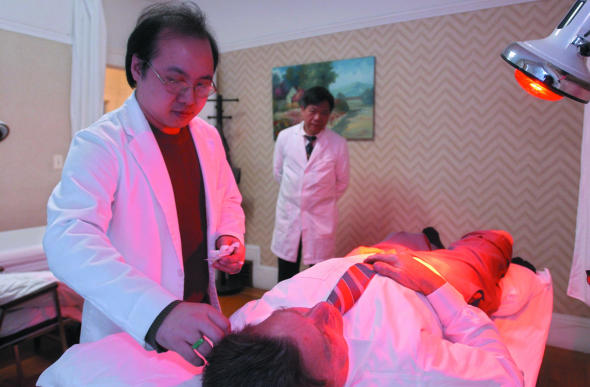Complementary and alternative therapies should be required to demonstrate their clinical effectiveness to the same standard as conventional medical treatments, says a new report from the US Institute of Medicine.
The report, which was prepared at the request of the National Institutes of Health and the Agency for Healthcare Research and Quality, assesses what is known about Americans' reliance on complementary and alternative medicine. It concludes that studies of the effectiveness and safety of such treatments are needed.
Figure 1.
An acupuncturist applies needles to a patient's ear. Acupuncture and other non-conventional treatments should be properly evaluated, says a new US report
Credit: JULIE JACOBSON/AP
The report estimates that more than a third of American adults routinely use complementary and alternative medicine, spending in excess of $27bn (£15bn; €21bn) a year. Forty two per cent of American adults report they have used at least one such therapy, but less than 40 per cent tell their doctors. In 1990 there were 425 million visits to providers of complementary and alternative medicine, compared with 388 million to primary care doctors. In addition, doctors are increasingly incorporating such medicine into their practices, and medical, nursing, and pharmacy schools are teaching their students about the subject.
“Since 1990 the growth in the use of [complementary and alternative medicine] by the public has been dramatic,” said Dr David Eisenberg of Harvard Medical School, Boston, who is a member of the Institute of Medicine's committee that drafted the report. Between 1990 and 1997 the use of herbal products increased by 380%.
But the use of complementary and alternative therapies should depend on whether they are safe and effective, and this mandates their evaluation. This is “easier said than done,” the report acknowledges. Many of the characteristics of such treatments make it difficult or impossible to conduct randomised controlled trials. Practitioners have variable approaches; there are customised treatments, treatment combinations, and outcomes that are difficult to measure. Although these characteristics are not unique to complementary and alternative medicine, they occur more often in these therapies than in conventional treatments, says the report.
“Innovative methods of evaluation are needed,” said Dr Stuart Bondurant of Georgetown University Medical Center, Washington, DC, who is the chairman of the committee that drafted the report. The report cites observational and cohort studies and case-control studies as possible ways to determine effectiveness.
The report recommends a priority system to determine which therapies to evaluate. It would include a plausible mechanism for the intervention, the high prevalence of a condition, and significant potential benefit.
It also suggests that the law regulating dietary and herbal supplements needs to be revised to strengthen quality control and labelling accuracy and to deal with inaccurate and misleading health claims. “Reliable and standardised products are needed if studies to determine safety and efficacy of dietary supplements are to be conducted,” said Dr Bondurant.
Congress passed legislation to control these products in 1994, but final regulations implementing it have not yet been published.
The report, Complementary and Alternative Medicine in the United States, is available at www.nap.edu



